Related Research Articles

Richard Boyle, 3rd Earl of Burlington and 4th Earl of Cork, was a British architect and noble often called the "Apollo of the Arts" and the "Architect Earl". The son of the 2nd Earl of Burlington and 3rd Earl of Cork, Burlington never took more than a passing interest in politics despite his position as a Privy Counsellor and a member of both the British House of Lords and the Irish House of Lords. His great interests in life were architecture and landscaping, and he is remembered for being a builder and a patron of architects, craftsmen and landscapers, Indeed, he is credited with bringing Palladian architecture to Britain and Ireland. His major projects include Burlington House, Westminster School, Chiswick House and Northwick Park.

Mayfair is an area of London, England, in the City of Westminster. It is in Central London and part of the West End. It is between Oxford Street, Regent Street, Piccadilly and Park Lane and one of the most expensive districts in the world.

Robert Adam was a British neoclassical architect, interior designer and furniture designer. He was the son of William Adam (1689–1748), Scotland's foremost architect of the time, and trained under him. With his older brother John, Robert took on the family business, which included lucrative work for the Board of Ordnance, after William's death.

Lismore Castle is a castle located in the town of Lismore, County Waterford, Ireland. It belonged to the Earls of Desmond, and subsequently to the Cavendish family from 1753. It is currently the Irish home of the Duke of Devonshire. It was largely re-built in the Gothic style during the mid-nineteenth century for the 6th Duke of Devonshire.

Savile Row is a street in Mayfair, central London. Known principally for its traditional bespoke tailoring for men, the street has had a varied history that has included accommodating the headquarters of the Royal Geographical Society at 1 Savile Row, where significant British explorations to Africa and the South Pole were planned; and more recently, the Apple office of the Beatles at 3 Savile Row, where the band's final live performance was held on the roof of the building.
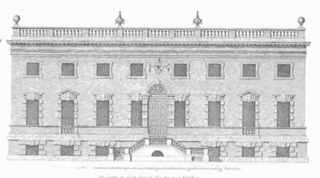
Colen Campbell was a pioneering Scottish architect and architectural writer who played an important part in the development of the Georgian style. For most of his career, he resided in Italy and England. As well as his architectural designs, he is known for Vitruvius Britannicus, three volumes of high-quality engravings showing the great houses of the time.

Gibside is an estate in Tyne and Wear, North East England. It is located in the valley of the River Derwent on the border with County Durham, between Rowlands Gill and Burnopfield. The estate is the surviving part of a Georgian landscaped park, primarily created under the ownership of Sir George Bowes (1701–1760) and designed in large part by Stephen Switzer and William Joyce.
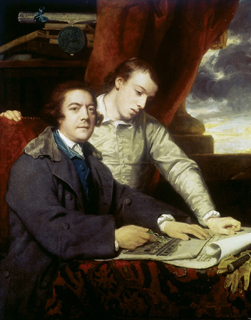
James Paine (1717–1789) was an English architect. He worked on number of country houses such as Chatsworth House, Thorndon Hall and Kedleston Hall.

John Carr (1723–1807) was a prolific English architect, best known for Buxton Crescent in Derbyshire and Harewood House in West Yorkshire. Much of his work was in the Palladian style. In his day he was considered to be the leading architect in the north of England.

Henry Vane, 2nd Earl of Darlington was a British peer.
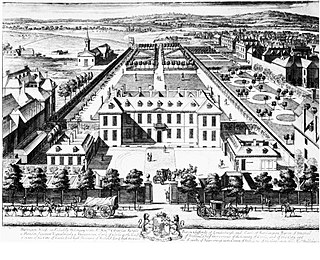
The Burlington Estate is an area in Mayfair to the north of Piccadilly in the West End of London, England. It was developed in the 18th century and owned by the Anglo-Irish Boyle dynasty, Earls of Burlington, in particular Richard, 3rd Earl of Burlington and 4th Earl of Cork (1694–1753).
Wentworth Castle is a grade-I listed country house, the former seat of the Earls of Strafford, at Stainborough, near Barnsley in South Yorkshire, England. It is now home to the Northern College for Residential and Community Education.

Savile Row tailoring is men and women's bespoke tailoring that takes place on Savile Row and neighbouring streets in Mayfair, Central London. In 1846, Henry Poole, credited as being the "Founder of Savile Row", opened an entrance to his tailoring premises at No. 32 Savile Row. The term bespoke is understood to have originated in Savile Row when cloth for a suit was said to "be spoken for" by individual customers. The short street has been termed the "golden mile of tailoring", where customers have included Charles III, Winston Churchill, Lord Nelson, Napoleon III, Muhammad Ali Jinnah, Laurence Olivier and Duke Ellington.

Fortress House was a building with its main entrance at 23 Savile Row in London W1, also including 5–9 New Burlington Street. It was built in 1949–50 to a design by Anthony Lloyd, and demolished in 2009.
Rupert William Lycett Green is a British fashion designer known for his contribution to 1960s male fashion through his tailor's shop/boutique Blades in London.

Burlington Gardens is a street in central London, on land that was once part of the Burlington Estate.
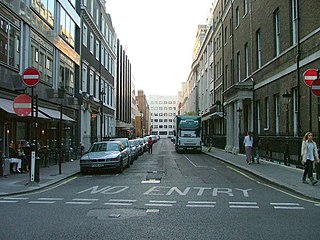
Old Burlington Street is a street in central London that is on land that was once part of the Burlington Estate.

New Burlington Street is a street in central London that is on land that was once part of the Burlington Estate. The current architecture of the street bears little resemblance to the original design of the street when first built in the early eighteenth century.
George Squibb was a British auctioneer, succeeding his father James, who founded the auction house of Squibb & Son, and working from public rooms in Boyle Street, facing down Savile Row, London, where the elder Squibb had set up in 1778. The grand rooms had been built in the 1730s, at the time Lord Burlington was developing the second phase of his real estate venture at the end of Burlington House gardens; they were extended by Squibb with a top-lit auction room. In 1813 he sold the collection of paintings of the late Duke of San Pietro. Among the country house auctions that fell under his hammer was that of the contents of Streatham Park, sold for Hester Thrale Piozzi in May 1816. Among those associated with Squibb was Michael Bryan, the connoisseur and author of the Dictionary of Painters
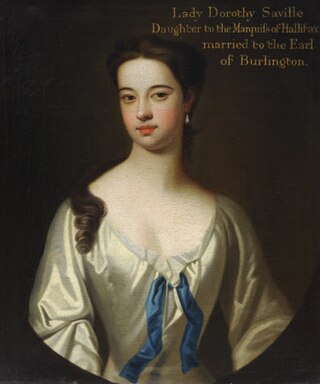
Dorothy Boyle, Countess of Burlington and Countess of Cork was a British noble and court official, as well as a caricaturist and portrait painter. Several of her studies and paintings were made of her daughters. Through her daughter Charlotte, who married the 4th Duke of Devonshire. A collection of 24 of her works of art descended to the Duke of Devonshire and kept at Chatsworth House.
References
- ↑ Daniel Garrett : Oxford Biography Index entry
- 1 2 Cork Street and Savile Row Area - Introduction | British History Online
- ↑ "The Landmark Trust | Featured Buildings". Archived from the original on 27 October 2007. Retrieved 28 November 2007.
- ↑ "SINE Project, Structure Details for Raby Castle". Archived from the original on 15 May 2011. Retrieved 28 November 2007.
- ↑ Daniel Garrett: Information and Much More from Answers.com
- ↑ Designs and estimates of farm houses &c. for the County of York, Northumberland, Cumberland, Westmoreland and Bishoprick of Durham [WorldCat.org]